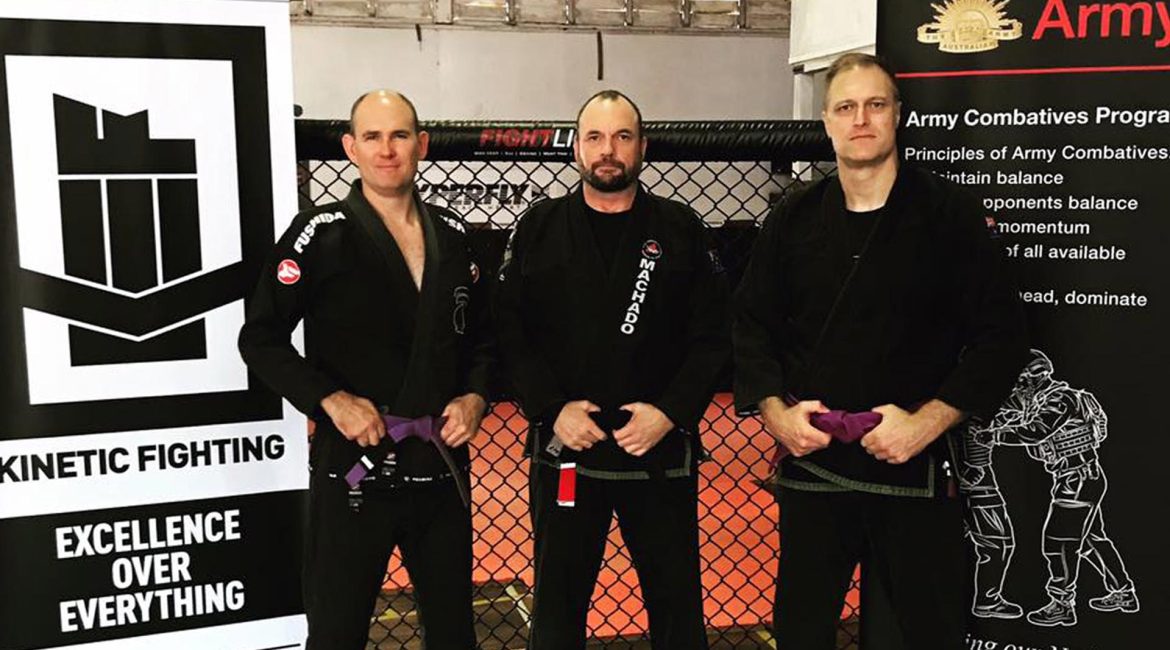Kinetic Fighting–Integrated Combat (KEF–IC) has been officially recognised as a martial art by the Australian Defence Force Martial Arts Association (ADFMAA).
The news came as Kinetic Fighting’s creator, Paul Cale, taught his third public KEF–IC course since launching it earlier in 2019. This was quickly followed by another milestone, when the next day Cale was promoted to the martial arts rank of 7th Degree. The events took place during the KEF–IC Level 1-Alpha and Level 1-Bravo courses held in Brisbane on 30 and 31 March.
“I’m truly overwhelmed and humbled by this acknowledgment of my life’s work, and I thank all of you for your support,” Cale told Facebook followers after the presentation.
The recognition comes some 13 years after the KEF–IC system first began to take shape. Cale started formulating what would become Kinetic Fighting (KEF) while serving as a Commando sergeant back in 2006. He’d been assigned to redevelop the Close-Quarter Fighting (CQF) package for Australian Special Forces and began applying his many years of experience, both in soldiering and martial arts, to the task.
“Although I didn’t use the name ‘Kinetic Fighting’ until around 2007, this system has been more than 40 years in the making,” said Cale.
The KEF–IC founder began his martial arts training as a child in the late 1970s. Today, he holds Black-belt ranks in multiple martial arts including Brazilian jiu-jitsu (BJJ), aikido, karate and judo.
“You could say that KEF–IC is the result of hundreds, if not thousands, of years’ development, as I’ve built upon the lessons and experiences of warriors from many other eras and cultures,” Cale said. “Most importantly, though, I thank those I’ve served and trained with, as the biggest influence on Kinetic Fighting has been my many years of experience on the modern battlefield.”
ADFMAA recognition means that KEF–IC will now be taught officially in Army’s Integrated Combat Clubs (ICC). Housed within major ADF bases around Australia, these clubs enable soldiers to train recreationally in various martial arts and also to practise their close-combat skills. Cale himself established the first ICC in 2011 at Sydney’s Holsworthy Barracks, home of the 2nd Commando Regiment.
“This recognition is a step forward in making KEF–IC more accessible to Defence personnel outside of Army,” Cale said. “Serving personnel use martial arts to keep fit, fight depression and develop their self-protection capabilities…KEF–IC enables them to do so in a way that not only complements but advances their combatives training. The system is unique in that its technical basis is the very same as that of the Army Combatives Program (ACP).”
KEF–IC, also known within the Australian Army as ACP–IC, is an extension of Cale’s military close-combat system, Kinetic Fighting. That in turn is the basis for ACP, which is now taught to all Army recruits and officers.
KEF–IC is so named because it integrates sport-combat elements and competition to support ongoing training, beyond the essential ACP or KEF short-courses. Through KEF–IC, soldiers can test and develop their combative skill sets to whatever level they desire. Likewise, civilians who complete Kinetic Fighting’s Personal Combatives short courses can choose to pursue mastery of the skills through further KEF–IC training and grading.
Cale’s ongoing contribution to the re-establishment of martial arts in the army has been recognised previously, having been named the ADFMAA’s honorary Head Coach in February 2017.
It was the ADFMAA’s president, Colonel Dr David Ward, who delivered the news of KEF–IC’s recognition in Brisbane. Ward, Associate Professor of Medicine, surgeon and Army medic, was first introduced to martial arts by Cale himself in 2010, when both men were deployed in Afghanistan.
Together with ADFMAA Vice President and Sergeant Major of the 7th Combat Brigade Combatives Centre, WO2 Aaron Johnston, Cale and Ward have been instrumental in the ADFMAA’s development. It is now the Army’s largest recreational sporting association.
“We have a long history together, with Aaron having been trained by me during the early development of Special Forces Close-Quarter Fighting (CQF) at 2 Commando,” Cale said. “David, while deployed in Afghanistan as our doctor, would watch me and my lads roll together, along with American SOF operators. This would inspire him to take up BJJ after returning to Australia.”
Regular KEF–IC training is currently only available to soldiers through the ADFMAA-run ICCs. However, KEF courses for the public are running in Australia’s major cities and regional centres throughout 2019.
[ngg src=”galleries” ids=”8″ display=”basic_imagebrowser” display_view=”default”]




